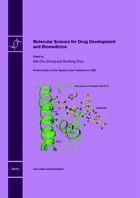Molecular Science for Drug Development and Biomedicine
A special issue of International Journal of Molecular Sciences (ISSN 1422-0067). This special issue belongs to the section "Biochemistry".
Deadline for manuscript submissions: closed (15 May 2014) | Viewed by 163885
Special Issue Editors
Interests: drug discovery and development; drug metabolism; pharmacokinetics/pharmacodynamics; cheminformatics; bioanalytical research
Special Issues, Collections and Topics in MDPI journals
Interests: drug discovery; systems pharmacology; cancer pharmacology; drug metabolism and transport; pharmacometrics; pharmacogenomics
Special Issues, Collections and Topics in MDPI journals
Special Issue Information
Dear Colleagues,
With the avalanche of biological sequences generated in the postgenomic age, molecular science is facing an unprecedented challenge, i.e., how to timely utilize the huge amount of data to benefit human beings. Stimulated by such a challenge, a rapid development has taken place in molecular science, particularly in the areas associated with drug development and biomedicine, both experimental and theoretical. The current thematic issue was launched with the focus on the topic of “Molecular Science for Drug Development and Biomedicine”, in hopes to further stimulate more useful techniques and findings from various approaches of molecular science for drug development and biomedicine.
Dr. Wei-Zhu Zhong
Prof. Dr. Shufeng Zhou
Guest Editors
Manuscript Submission Information
Manuscripts should be submitted online at www.mdpi.com by registering and logging in to this website. Once you are registered, click here to go to the submission form. Manuscripts can be submitted until the deadline. All submissions that pass pre-check are peer-reviewed. Accepted papers will be published continuously in the journal (as soon as accepted) and will be listed together on the special issue website. Research articles, review articles as well as short communications are invited. For planned papers, a title and short abstract (about 100 words) can be sent to the Editorial Office for announcement on this website.
Submitted manuscripts should not have been published previously, nor be under consideration for publication elsewhere (except conference proceedings papers). All manuscripts are thoroughly refereed through a single-blind peer-review process. A guide for authors and other relevant information for submission of manuscripts is available on the Instructions for Authors page. International Journal of Molecular Sciences is an international peer-reviewed open access semimonthly journal published by MDPI.
Please visit the Instructions for Authors page before submitting a manuscript. There is an Article Processing Charge (APC) for publication in this open access journal. For details about the APC please see here. Submitted papers should be well formatted and use good English. Authors may use MDPI's English editing service prior to publication or during author revisions.
Keywords
- protein–protein interaction
- protein attribute identification
- protein-drug interaction
- multi-label biological systems
- post-translational modification
- drug metabolism
- pharmacokinetics/pharmacodynamics
- graphic analysis
- pseudo amino acid composition
- pseudo oligonucleotide composition







